
“If developed properly, human capital can contribute to an enduring, sustainable, and competitive advantage for today’s organizations.” - Fred Luthans
We are no longer managing in predictable times. A collision of forces is redefining today’s workplace: the rapid rise of AI, an exhausted managerial class, and a disengaged workforce. The systems we once trusted to deliver performance and culture are breaking down, and many leaders are still trying to apply outdated fixes to entirely new problems.
Consider this: According to Gallup’s 2025 State of the Global Workplace Report, global employee engagement fell from 23% to 21% in 2024. This decline has only been matched once before, during the height of the COVID-19 crisis. The cost of that disengagement? An estimated $438 billion in lost productivity in a single year.
Source: State of the Global Workplace Report
This isn’t a dip. It’s a signal.
Managers, once the vital bridge between strategy and execution, are burning out. Pressured from above and pulled from below, they are expected to meet rising performance goals while nurturing employee purpose, flexibility, and psychological safety. The result is a widespread breakdown in trust, clarity, and motivation.
The challenge here is structural.
Unless organizations rethink how they approach behavior, not just strategy, they will face more than a productivity slump. They will face a crisis of credibility, cohesion, and talent.
But here is the shift already underway:
Forward-thinking organizations are no longer treating Organizational Behavior (OB) as theory. They are using it as a strategic lens to tackle today’s biggest performance risks and build more adaptive, human-centered cultures in the process.
Here’s how they’re doing it:
- Diagnosing toxic cultural patterns before they damage trust or morale
- Equipping managers with the behavioral tools they need: coaching, clarity, and emotional intelligence
- Rewiring work environments for autonomy, well-being, and purpose
- Embedding psychological safety across teams and leadership
- Using behavioral data to shape action instead of simply reporting problems
This shift is not about soft skills. It is about hard results.
It is about making behavior a strategic capability that drives execution, retention, innovation, and growth.
So, organizational behavior is no longer the soft side of business; it is the infrastructure of everything you want to achieve.
Whether you are leading transformation, managing complex teams, or fixing a cultural fracture that is costing you top talent, this guide will equip you with:
- The foundational principles of Organizational Behavior every modern leader needs to know
- Actionable solutions to address challenges like burnout, poor communication, and resistance to change
- A real-world transformation story from a company that reshaped how it works by redesigning behavior
- A toolkit to measure, influence, and sustain behavioral change across levels
Let’s begin. Because when strategy and behavior align, the business doesn’t just perform.
It evolves.
What is Organizational Behaviour?
Organizational Behavior (OB) is about understanding how people think, feel, and act within the workplace. It’s the study of human behavior in organizations, examining why people do what they do and how those behaviors shape the success or setbacks of the business.
OB isn’t soft theory. It’s a cross-disciplinary field that blends psychology, sociology, anthropology, communication, economics, and systems thinking to answer hard business questions:
- What really motivates teams to perform at their best? (Explore our guide: How to Build Motivation in Teams)
- How do groups stay cohesive and focused under intense pressure? (See our blog: How to Build Collaborative Teams)
- Why do some organizations withstand disruption while others collapse? (Read: Business Continuity & Succession Planning)
Over the last decade, OB has evolved into an evidence-based practice that helps organizations design for behavior change rather than just hoping for it.
Modern leaders aren’t waiting to “see how culture evolves.” They’re shaping it.
At Whole Foods, CMMO Sonya Gafsi Oblisk replaced top-down directives with frequent store visits and feedback loops rooted in trust-building real-time alignment across hundreds of distributed teams. At Oliver, a global marketing agency, OB principles were embedded into the HR platform, so employees interact with core values daily, not just during onboarding.
These aren’t cultural add-ons. They’re OB in action aligning how people behave with how the business grows.
Three-Level Framework Of Organizational Behavior
To truly understand how people behave in organizations, why they thrive, why they struggle, and how they influence one another, we must examine behavior through three interconnected lenses:
- The Individual Level
- The Group Level
- The Organizational Level
Each of these layers shapes the others. A change at one level, be it a person, a team, or the organization, inevitably ripples across the system.
Let’s walk through each one.
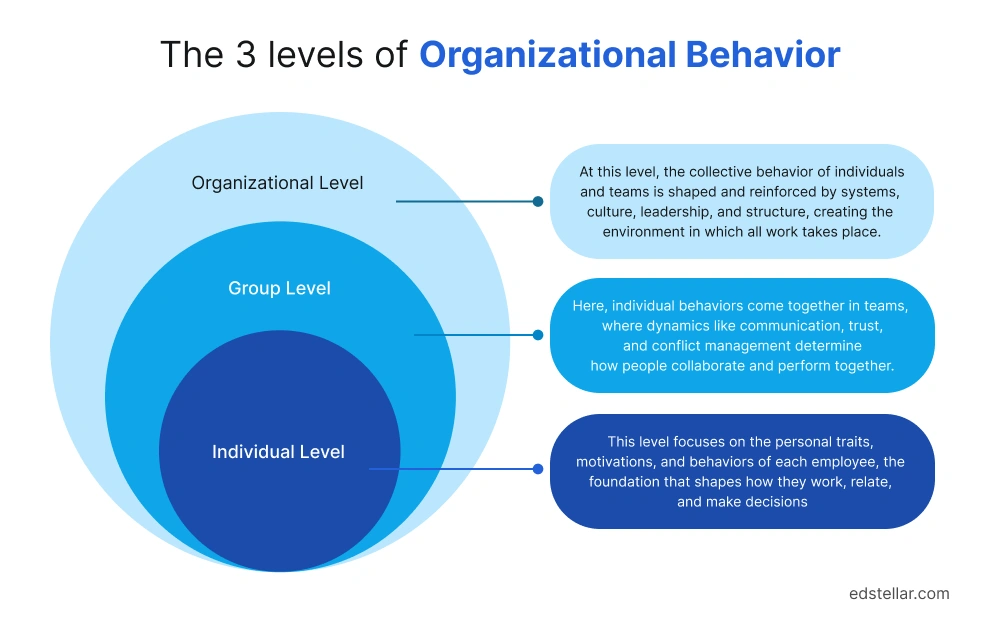
Individual Level in Organizational Behavior: Understanding Personal Drivers of Performance
Organizations don't think, feel, or act, but people do. And every policy, strategy, or transformation ultimately succeeds or fails based on individual behaviors. That's why the individual level forms the foundation of Organizational Behavior (OB). It's not just about knowing your people; it's about understanding how personal drivers shape collective performance, leadership potential, and cultural alignment.
In OB literature, there are dozens of behavioral variables. But in practice, these five consistently emerge as the most measurable, coachable, and consequential across leadership development, change programs, and performance initiatives:
- Personality & Traits: These shape how people respond to challenges, ambiguity, or collaboration. For example, an introverted yet conscientious employee may quietly drive high-quality work, while an extroverted leader may energize cross-functional teams. When organizations design roles or teams without accounting for personality fit, misalignment and conflict often follow.
- Attitudes & Values: These define what people care about and what they resist. If your company champions innovation but employees value stability, you'll encounter friction. Conversely, when there's value alignment between individuals and organizations, you unlock commitment, ownership, and trust.
- Perception & Bias: People don't respond to reality; they respond to their perception of it. Unconscious bias and cognitive filters shape how individuals interpret feedback, risk, or leadership intent. These subtle distortions can lead to microaggressions or unintended exclusions, ultimately influencing critical outcomes like hiring, promotions, inclusion, and innovation. Leaders who recognize these patterns can redesign systems to be more equitable, aware, and effective.
- Motivation Factors: Motivated employees don't just complete tasks. They take the initiative, improve processes, and inspire peers. But motivation is deeply personal. One employee thrives on autonomy, another on purpose, and another on recognition. Ignoring these distinctions leads to disengagement and attrition. Meeting them elevates energy across the org.
- Emotional Intelligence (EQ): In high-stress, fast-moving environments, emotional intelligence is often more predictive of leadership success than IQ. Leaders with strong EQ diffuse tension, navigate change empathetically, and foster psychological safety, which is essential for team resilience, innovation, and retention.
These five are evidence-based pillars that consistently emerge across OB research, leadership models, and performance frameworks. Together, they answer a core leadership question: How do we understand, develop, and lead people in ways that elevate performance without burning them out?
Critically, these individual behaviors shape how teams collaborate, how culture is formed, and how strategic decisions play out. That's why any organizational shift from transformation initiatives to leadership excellence must begin here.
As we move into the group level of OB, we'll explore how these individual attributes interact, amplify, or conflict when people come together in teams and what leaders can do about it.
Group Level in Organizational Behavior: Turning Team Dynamics into Competitive Advantage
In the previous section, we examined how individual attributes. However, individuals rarely work in isolation. Most work happens in teams. And teams have their own dynamics that can either boost performance or hold it back.
This is where the second layer of Organizational Behavior becomes critical: the group level.
At this level, the focus shifts from the internal makeup of a person to how people operate together. The individual dynamics you just saw, such as emotional intelligence or perception, become the raw ingredients for group phenomena: trust, alignment, communication breakdowns, conflict cycles, or team synergy.
OB doesn't view teams as static structures. It treats them as living, behavioral systems shaped by individual inputs but sustained by shared norms, power structures, and leadership cues. That's why leaders who understand group behavior don't just manage people; they design high-performing ecosystems.
Let's break this down further:
- Team Formation & Lifecycle: Teams don't simply "click." They move through classic stages of forming, storming, norming, and performing, each fraught with behavioral risk. If not guided carefully, storming can devolve into destructive conflict. Leaders who understand this arc can anticipate turning points and coach teams to the performing stage faster.
- Group Dynamics & Hidden Forces: Under the surface, invisible dynamics of power, alliances, and the diffusion of responsibility shape outcomes. Classic studies on the Ringelmann effect (groups pulling a rope less hard than individuals) and social loafing demonstrate how performance declines as group size increases. Leaders who hold individuals accountable, define clear roles, and prevent the diffusion of responsibility can prevent hidden losses.
- Communication Patterns & Trust: Effective teams don't just exchange information; they communicate transparently, with purpose and feedback loops. Leading organizations adopt structured check-ins, such as daily "stand-ups" or weekly "safety check" rounds, to ensure alignment. Purposeful business communication strengthens trust and accelerates problem-solving.
- Conflict Management & Innovation: Healthy conflict sparks innovation, but only with effective conflict management. Structured approaches like "challenge ideas, not people" ensure debates stay respectful and solutions-focused. Teams strengthen conflict management by using real-time feedback and rotating a "devil's advocate" role, where one member critically questions ideas to expose blind spots and improve decision-making.
- Leader Behavior & Team Culture: The team's leader sets the behavioral tone. Inclusive leadership asking questions, acknowledging mistakes, and inviting dissent builds psychological safety at work. Research indicates that management teams with high psychological safety are more collaborative, share information more effectively, and perform better. Conversely, weak or authoritarian leadership stifles engagement and creativity.
These group-level elements don't exist in isolation. They respond to individual traits (like EQ and motivation) and feed into broader organizational culture. A high-EQ leader can navigate conflict (group level) only if they also understand how personality and bias (individual level) shape the situation. A culture that rewards accountability (organizational level) strengthens communication and norms within teams. Today's organizations need this layered lens to develop Agile teams capable of delivering consistently under pressure.
Organizational Level in Organizational Behavior: Building a Culture That Drives Success
At the broadest level, we look at the organization as a whole, the environment in which individuals and teams operate. This is where decisions about culture, structure, strategy, and systems either enable people to thrive or hold them back.
- Culture & Climate: This refers to the shared values, beliefs, and attitudes that influence how people behave on a daily basis. A strong, positive culture creates a sense of belonging, trust, and accountability. Without it, even the best strategies fail.
- Structure & Design: How an organization is structured hierarchies, roles, and reporting lines either support or block performance. A clear, flexible structure helps teams collaborate, make faster decisions, and adapt to change.
- Change Management: Organizations must evolve to stay relevant, but change impacts more than just strategy. It affects individual mindsets, group dynamics, and organizational culture. Poorly managed change can unravel trust, performance, and engagement. Effective change management preserves the behavioral fabric of the organization by guiding people through uncertainty, aligning teams, and reinforcing values, ensuring that transformation strengthens, rather than disrupts, how people think, work, and lead.
- Systems & Processes: Even the best talent will struggle without the right tools and workflows. Efficient, streamlined systems ensure that people spend less time on bottlenecks and more time adding value. It’s about aligning how work gets done with the organization’s goals.
- Strategic Alignment: This ensures that every team, process, and decision supports the organization’s overall mission and direction. When alignment is missing, efforts become fragmented, progress stalls, and people lose motivation.
From Levels to Levers: Why Motivation Powers Every Layer of Organizational Behavior
Until now, we've looked at behavior through three distinct lenses: individual, group, and organizational levels. Each offers a critical perspective. But in real workplaces, behavior rarely stays confined to one level. It spills across roles, teams, and systems, driven by deeper forces that operate regardless of hierarchy or job function.
Motivation is one of those forces.
Whether you're helping a high-performer break through a plateau, guiding a team through conflict, or aligning culture to strategy, what truly moves people to act (or not) lies beneath the surface. Without understanding these motivational drivers, even the best leadership techniques or organizational structures fall flat.
This is why we now turn to the cross-cutting themes with motivation at the center. In this section, we'll explore how motivation theories help leaders at every level decode behavior, build engagement, and guide change that sticks.
Let's break them down.
Motivation Theories in Organizational Behavior: What Drives People at Work
At every level, understanding why people act the way they do is essential for unlocking performance. Motivation isn’t one-size-fits-all. It’s influenced by both what motivates people (content theories) and how motivation works (process theories).
Content Theories:
- Maslow’s Hierarchy of Needs: Applying Motivation Theory to the Workplace
One of the most widely recognized theories of motivation is Abraham Maslow's Hierarchy of Needs. It suggests that human behavior is driven by the desire to satisfy specific categories of needs arranged in a five-level pyramid.
At work, as in life, people are motivated to fulfill the needs that matter most to them at the moment. Once a lower-level need is satisfied, they naturally move up the pyramid.
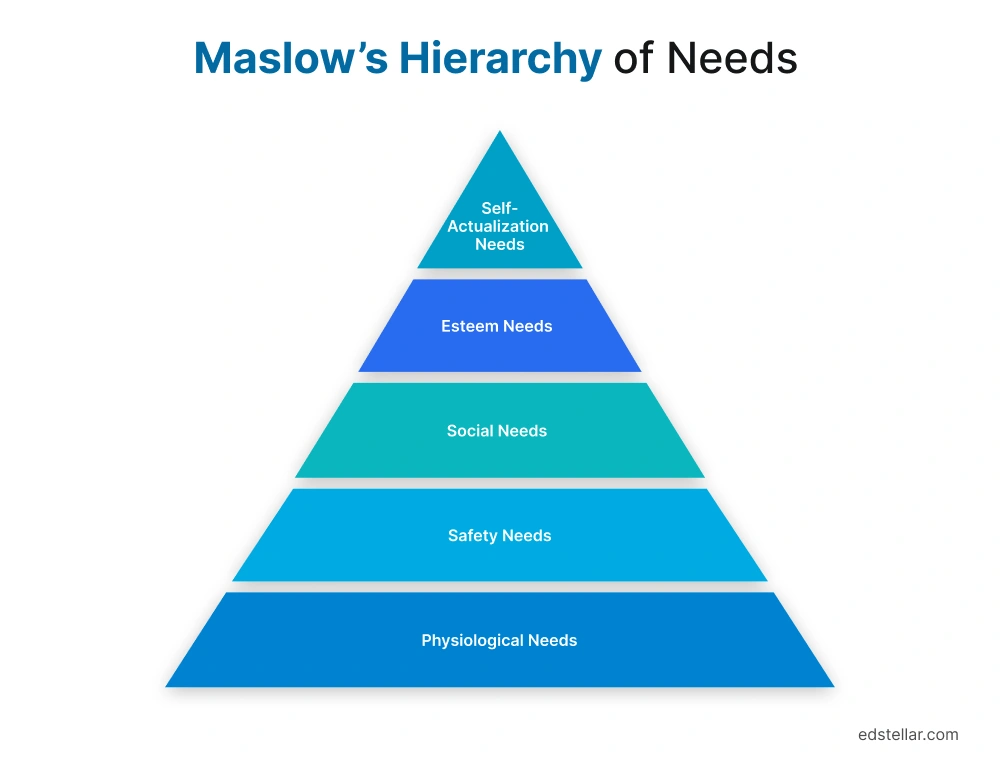
Here's a quick walk of each level:
1. Physiological Needs: At the base of the pyramid are the basic survival needs: food, water, shelter, and sleep. In organizational terms, this translates to fair pay, comfortable working conditions, and job stability fundamentals without which no higher motivation can flourish.
2. Safety Needs: Once basic needs are met, people seek security and safety, which encompasses physical safety, financial stability, and freedom from fear. Organizations address this through stable employment, safe workplaces, clear policies, and health benefits.
3. Social Needs: Human beings are social creatures. This level reflects the need for belonging, relationships, and acceptance. Workplace friendships, inclusion, collaboration, and team belonging all satisfy this layer.
4. Esteem Needs: Next comes the need for self-respect, recognition, and a sense of accomplishment. Employees look for opportunities to grow, contribute meaningfully, and be appreciated for their efforts.
5. Self-Actualization Needs: At the top of the hierarchy is the drive to maximize one's potential to learn, innovate, lead, and make an impact. Organizations that provide development, stretch opportunities, and purpose help people reach this level.
In the workplace, people are motivated by different needs at different times. To truly engage your workforce, you must create an environment that helps people move up the pyramid, not just survive at the bottom.
- Herzberg’s Two-Factor Theory: Boosting Job Satisfaction and Employee Motivation
Another powerful lens for understanding workplace behavior is Herzberg’s Motivation-Hygiene Theory. Developed by psychologist Frederick Herzberg and his team, this theory helps explain why people feel satisfied or dissatisfied at work and why those two feelings aren’t always opposites.
Herzberg’s research found that job satisfaction and dissatisfaction stem from two distinct sets of factors rather than a single spectrum. This means that simply removing dissatisfaction doesn’t automatically create motivation or happiness.
Let’s break it down:
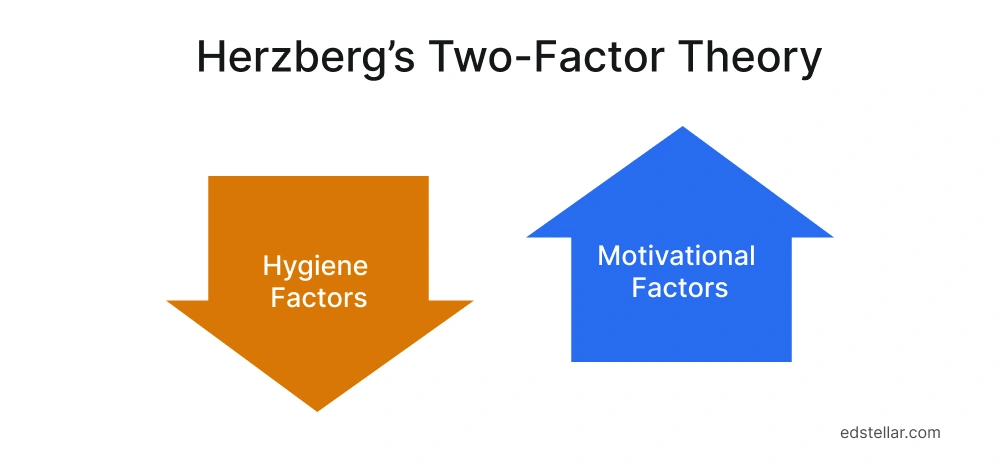
1. Hygiene Factors (Think: “Preventing Unhappiness”)
These are basic things people expect from any decent workplace. If these are missing or poorly handled, people feel unhappy, frustrated, or even leave.
Examples of Hygiene Factors:
- Salary (being paid fairly)
- Job security (not fearing layoffs)
- Safe, clean working conditions
- Good management policies
- Respectful relationships with coworkers
But even if you provide these things perfectly, they won’t make people truly motivated or inspired. They’ll just prevent complaints.
2. Motivational Factors (Think: “Inspiring People to Excel”)
These factors actually drive people to perform better, stay engaged, and feel satisfied. They’re linked to what makes the work itself meaningful. When these are present, people feel fulfilled, take ownership, and go the extra mile.
Examples of Motivational Factors:
- Recognition for doing great work
- Achieving challenging goals
- Feeling trusted with responsibility
- Opportunities for growth, learning, and advancement
- Doing work that feels purposeful
If they’re missing, people may feel indifferent, but they won’t necessarily be upset or angry like with hygiene factors.
- McClelland’s Three Needs Theory: Uncovering Deep Workplace Motivators
While some motivation theories focus on basic needs or external rewards, David McClelland’s Three Needs Theory looks deeper into the inner drivers that shape how people behave in the workplace.
After three decades of research, McClelland concluded that while every person has multiple motivations, most are primarily driven by one of three core needs:
- The need for achievement
- The need for power
- The need for affiliation
Recognizing which of these is dominant in your people is essential for creating environments where individuals feel energized, valued, and inspired to perform. This is a tool for any leader who wants to unlock real, sustainable behavior change.
1. The Need for Achievement (nACH): The Drive to Excel
People who are primarily driven by achievement are motivated by the desire to improve, accomplish challenging goals, and outperform expectations. They set high standards for themselves and often measure success by tangible results.
They are typically:
- Highly focused on personal responsibility, they want to own their successes (and sometimes their failures).
- Energized by moderate risks where outcomes are within their control.
- Motivated by clear, measurable feedback that helps them track their progress.
In practice, achievement-driven individuals thrive when given challenging projects and autonomy. They don’t just want to do the job; they want to do it better than it’s ever been done before.
However, these individuals may sometimes struggle with delegation or collaborative work, preferring to control outcomes directly.
2. The Need for Power (nPOW): The Desire to Influence
The second driver is the need for power, the desire to influence others, lead change, and hold responsibility for outcomes beyond oneself.
For those with a high need for power:
- The motivation lies in having an impact, not necessarily in status for its own sake.
- They often seek leadership roles where they can direct teams, make decisions, and shape the organization’s path.
When channeled positively, power-driven individuals can become strong, decisive leaders who inspire others and drive performance.
Left unchecked, however, this motivation can manifest as authoritarian behavior or political maneuvering.
For organizations, this means ensuring that power-driven individuals are guided toward influence for impact, not control for control’s sake.
3. The Need for Affiliation (nAFF): The Urge to Belong
The third need, often overlooked but equally important, is the need for affiliation: the drive to form meaningful relationships and be accepted by others.
Affiliation-driven individuals:
- They are happiest in roles that involve teamwork, cooperation, and positive interpersonal interactions.
- Avoid conflict and may prioritize group harmony over personal ambition.
- Value stability, familiarity, and strong workplace relationships.
While these individuals may not always push aggressively for advancement, they are the glue that holds teams together. They thrive in roles where collaboration and trust are critical to success.
Process Theories:
- Expectancy Theory of Motivation: How Beliefs Drive Performance
When it comes to motivation in the workplace, one of the most insightful models comes from Victor Vroom’s Expectancy Theory of Motivation. This theory moves beyond the question of what people need or want and focuses instead on how people think when deciding whether to put in effort.
At its core, Expectancy Theory is about one simple idea:
People are motivated when they believe their effort will lead to good performance, that good performance will lead to rewards, and that the rewards will be meaningful to them.
If any one of these links is broken, motivation falters.
The Three Pillars of Expectancy Theory:
Vroom’s model says that motivation is the product of three psychological drivers, all of which must be present for someone to feel motivated to act:
1. Expectancy: “If I try harder, will I succeed?”
This is the belief that effort leads to performance.
If people don’t believe they have the skills, tools, or support to succeed, no matter how attractive the reward, they simply won’t try.
2. Instrumentality: “If I succeed, will I be rewarded?”
This is the belief that performance leads to outcomes.
People must trust that if they meet expectations or deliver results, they will actually receive the promised rewards. Broken promises or inconsistent recognition erode this link.
3. Valence: “Do I care about the reward?”
This refers to the value a person places on the outcome itself.
Rewards can be extrinsic (bonuses, promotions) or intrinsic (growth, recognition, fulfillment). If the reward doesn’t matter to the individual, motivation will stay low.
For leaders, Vroom’s model is a powerful reminder that motivation is not automatic. People can lose motivation if:
- They don’t believe their effort will make a difference (low Expectancy).
- They doubt that results will lead to meaningful rewards (low Instrumentality).
- They simply don’t care about the outcome (low Valence).
To bring this theory to life in your leadership practice:
- Provide Rewards that People Actually Value: Not everyone is motivated by money. For some, it’s recognition, purpose, flexibility, or growth. Know your people.
- Set Achievable, Supported Goals: People must believe that their success is within reach. This means ensuring they have the skills, authority, and resources they need.
- Follow Through on Promised Outcomes: If people see that effort and success don’t consistently lead to rewards, trust breaks down. And when trust breaks, motivation collapses.
Limitations to Consider:
Like all theories, Expectancy Theory isn’t perfect:
- In some organizations, rewards don’t always align tightly with performance. They may be tied to hierarchy, politics, or external factors.
- People’s perceptions may not always match reality. What they believe matters more than what’s objectively true.
The Leadership Takeaway:
In every organization, people constantly weigh: Is it worth it for me to give my best effort?
As leaders, it’s our job to ensure the answer is “yes” by:
- Making the path to success clear
- Ensuring rewards are fair and consistent
- Connecting outcomes to what people truly value
When you manage these three levers well, motivation doesn’t have to be forced; it becomes natural.
- Goal Setting Theory: How Clear, Challenging Goals Drive Motivation and Results
One of the most practical and widely used motivation theories in business today is Edwin Locke’s Goal Setting Theory. Introduced in the 1960s, this theory makes a simple but powerful claim:
Clear, specific, and challenging goals drive higher performance.
It’s not enough to tell people to “do their best” or “work hard.” People perform better when they know exactly what they’re aiming for, why it matters, and how they’ll measure success.
How Goal Setting Shapes Behavior:
According to Locke’s theory, several key principles explain why goals have such a strong impact on motivation and outcomes:
1. Specificity Matters
The more specific and unambiguous a goal is, the more it motivates action. Telling a team to “increase customer satisfaction” is too vague. Saying, “Increase our Net Promoter Score by 10 points in 6 months,” provides direction, clarity, and urgency.
2. Challenge Fuels Engagement
Goals that are challenging but realistic inspire people to stretch themselves. When people achieve a difficult goal, they experience pride, mastery, and renewed motivation to aim higher.
3. Feedback Drives Progress
Without feedback, goals lose their power. People need timely, actionable information on how they’re doing so they can adjust efforts, celebrate wins, or refocus where needed.
4. Goal Commitment is Key
Goals only work when people are committed to them. Commitment grows when:
- People are involved in setting the goal.
- Goals are publicly shared and visible.
- Goals align with personal values and organizational purpose.
Additional Factors that Influence Goal Success:
- Self-Efficacy: The belief in one’s own ability to achieve the goal. The higher the confidence, the greater the effort, persistence, and resilience.
- Goal Alignment: For goals to be motivating, they must connect with both the individual’s values and the broader organizational vision. Misaligned goals lead to confusion, frustration, or disengagement.
What This Means for Leaders and Organizations
Goal Setting Theory offers a practical roadmap for leaders who want to drive results while engaging their teams:
- Set SMART Goals: Goals should be Specific, Measurable, Achievable, Relevant, and Time-bound.
- Involve People in the Process: Where possible, co-create goals with your teams rather than imposing them top-down. This builds ownership and commitment.
- Provide Ongoing Feedback: Don’t wait until the end. Regular check-ins, progress reviews, and celebrations keep momentum alive.
- Balance Challenge and Support: Set goals that push people, but ensure they have the resources, skills, and support to succeed.
Limitations to Keep in Mind:
- Goals that are too difficult or misaligned can backfire, leading to stress, burnout, or risky behavior.
- Not all goals enhance job satisfaction; they can improve performance without necessarily increasing happiness.
- Skill gaps can undermine motivation if people feel the goals are out of reach.
Common Organizational Behavior Challenges and How to Solve Them
While organizational behavior (OB) theories and frameworks give us the tools to understand human dynamics at work, applying them to real-world challenges is where transformation happens. Here are four of the most common organizational behavior challenges, along with practical, research-backed solutions.
Challenge 1: Low Employee Engagement
Symptoms: High turnover, low productivity, absenteeism, lack of discretionary effort.
Engagement falters when employees feel disconnected from their work, their leaders, or the organization’s purpose. People need to feel valued, heard, and supported to thrive.
OB Solutions:
- Job Redesign for a Better Fit: Apply Herzberg’s Two-Factor Theory to Enhance Motivators Like Meaningful Work and Recognition While Addressing Hygiene Factors to Remove Dissatisfaction.
- Recognition and Reward Programs: Cultivate a culture of appreciation where small, frequent recognition creates psychological safety and retention.
- Career Development Opportunities: Maslow’s Hierarchy reminds us that growth and self-actualization drive higher motivation to invest in learning pathways.
- Improved Manager-Employee Relationships: The Hawthorne Studies show that people perform better when they feel seen and valued.
Challenge 2: Poor Communication
Symptoms: Frequent misunderstandings, missed deadlines, conflict, and disengagement.
Poor communication stems from unclear channels, lack of trust, and one-way information flow that leaves employees confused or disengaged. Without open, two-way dialogue and clear feedback loops, misunderstandings and frustration quickly take root.
OB Solutions:
- Communication Skills Training: Improve both verbal and non-verbal communication.
- Clear Communication Channels: Use structured downward, upward, horizontal, and diagonal channels to ensure transparency.
- Regular Feedback Mechanisms: Apply Goal-Setting Theory to provide ongoing feedback that sustains motivation and clarity.
- Active Listening Workshops: Build trust through the two-way communication practices emphasized in the.
Challenge 3: Resistance to Change
Symptoms: Employee pushback, slow adoption of new processes, reduced performance.
Resistance to change is a natural human reaction rooted in fear of the unknown, potential loss, and lack of trust. People may worry about losing status, security, or competence in the new environment. Without clear communication, involvement, and support, change can feel threatening instead of inspiring, causing individuals to hold onto familiar ways of working even if those ways are no longer effective.
OB Solutions:
- Involve Employees in Change Planning: When people help shape change, they’re more likely to support it. Early involvement builds ownership, reduces fear, and aligns people emotionally with the transformation.
- Clear Communication About Benefits: Communicate not just what is changing, but why it matters. People need to see how the change connects to their own success and the organization’s purpose.
- Training and Support During Transition: Support employees with the tools, knowledge, and psychological safety they need to succeed in the new environment. Build self-efficacy by showing that success is achievable.
- Address Fears and Concerns Openly: Encourage honest dialogue. Acknowledge anxieties, listen to concerns, and respond with empathy, not dismissal.
The Future of Organizational Behavior (OB): Emerging Trends Shaping the Workplace
If the past decade has taught us anything, it’s this: change is the only constant. The way we work, lead, and organize is transforming faster than ever, and Organizational Behavior (OB) is at the heart of this evolution.
To stay relevant, resilient, and responsible, organizations must rethink how they approach behavior, culture, and leadership.
Leadership Takeaway: How to Lead With Organizational Behavior in a Changing World
The future of OB isn't about abandoning what we know; it's about embracing it. It's about building on it to meet new realities.
- The world is more connected.
- The workforce is more diverse.
- The pace of change is faster than ever.
In this environment, leaders who understand and shape behavior intentionally will have the edge not just in performance but in resilience, innovation, and reputation.
The future belongs to organizations that behave forward, where behavior, culture, and leadership evolve together to meet whatever comes next.
Applying Organizational Behavior: A Case Study and Toolkit for Business Impact
Understanding organizational behavior is one thing. Bringing it to life and putting it into practice in the real world is where leadership is tested and transformation truly happens.
To make this practical, let’s look at a real-world example: the story of HCL Technologies (HCLT) and how it turned traditional management on its head to become one of the fastest-growing IT service companies in the world. This isn’t just theory; this is Organizational Behavior in action.
The Case: HCL Technologies’ “Employees First, Customers Second”
In 2005, HCL Technologies (HCLT) faced a familiar challenge: a fast-changing business landscape but an outdated organizational structure. Like many companies, it was still managed with rigid, top-down approaches that no longer served its people or its performance.
Vineet Nayar, Vice Chairman and CEO, believed this had to change. His idea was simple but radical: put employees first, and customers second. This was about empowering the people who create value for them.
Through this lens, HCLT operationalized key Organizational Behavior concepts and made them part of its daily reality.
1. Mirror Mirror: Confronting the Truth (The Organizational Level)
HCLT began by establishing Point A, an honest, open assessment of its current reality. Through open conversations across the company, the leadership unveiled the truth about where HCLT stood and paired it with an inspiring vision of the future, a Point B that employees could believe in.
This was not about creating false optimism. It was about creating psychological safety for employees to see the need for change and to become active participants in it.
2. Building Trust through Radical Transparency (Group & Organizational Level)
To build the trust needed for change, HCLT threw open the windows of transparency, sharing the company’s financial information, both good and bad, with employees across the organization.
As Nayar described it, much like a house with large glass windows that stays clean because everything is visible, transparency exposes problems and encourages action. Employees could now see the dirt and were empowered to clean it up themselves
3. Inverting the Management Pyramid (Group Level)
HCLT turned the traditional organizational hierarchy upside down. Managers and enabling teams (like HR and finance) became accountable to the frontline employees, the people in what HCLT called the “value zone,” where the real value is created for customers.
To reinforce this shift, the company implemented an Open 360-degree Review where all employees could provide feedback to managers, and everyone had access to the results. This was not used to punish but to foster continuous development, making managers more effective in their roles by serving the needs of their teams.
4. Recasting the Role of the CEO (Individual & Organizational Level)
Finally, HCLT shifted the ownership of change from the CEO’s office to the employees.
Through the creation of the Value Portal, employees could submit suggestions and solutions for improvement. Over 500 ideas were implemented, creating more than $25 million in value.
Additionally, the Smart Service Desk (SSD) allowed any employee to raise issues directly, with resolution dependent on the employee’s sign-off, not just management’s decision.
These mechanisms ensured that decision-making, problem-solving, and innovation lived in the hands of those closest to the work, not just in the executive suite.
Practical Tools for Applying Organizational Behavior: How to Drive Lasting Change
The story of HCL Technologies shows that changing organizational behavior is both an art and a science. It requires not just bold leadership but also the right tools to measure, guide, and sustain change.
If you’re serious about bringing organizational behavior to life in your own organization, you need to start with assessment because you can’t shift what you don’t understand. Just as HCLT used open conversations, feedback loops, and transparency to surface the truth, you can use modern Organizational Behavior tools to diagnose, measure, and track behavior patterns.
Here are some practical tools you can apply right away:
Why These Tools Matter:
- Just like HCLT’s “Mirror Mirror” phase, you need to establish your Point A, a clear-eyed view of where you are today.
- Tools like the MBTI or the Big Five help you understand individual-level behaviors.
- Cultural surveys reveal the group and organizational patterns of the often-unspoken rules that shape daily behavior.
- Engagement metrics and 360-degree feedback give you continuous data to track progress, spot blind spots, and sustain change.
The OB Reality: What Gets Measured, Gets Managed
HCL’s transformation succeeded because they didn’t guess. They measured, experimented, and adapted. By combining the right leadership mindset with these practical OB assessment tools, you can build an organization where behavior fuels both performance and culture every day.
The Impact: How Organizational Behavior Shifted Performance:
The results were profound:
- HCLT achieved 24% CAGR growth and increased its market capitalization by 186% in three years.
- It doubled the number of major clients and significantly improved its revenue per employee, one of the highest in the Indian IT industry.
- HCLT gained global recognition, appearing in Fortune’s Executive Dream Team, Forbes Asia’s Fab 50, and other top rankings.
Key Takeaway: Organizational Behavior Made Real:
HCL’s story, as told in “Employees First, Customers Second,” demonstrates that behavior is the bridge between strategy and success:
- When people see reality clearly, they act.
- When they trust leadership, they engage.
- When they are empowered, they innovate.
The real secret? Behavior doesn’t change because you ask for it; it changes because you design for it.
Measuring Organizational Behavior Success: Metrics and ROI You Can Track
Organizational Behavior (OB) isn’t just about creating a “feel-good” environment. It’s about driving real, measurable outcomes that impact people, performance, and the bottom line. To sustain investment in OB practices, leaders need to track the right metrics that connect human behavior to organizational success.
This section explores how to measure OB across the Individual, Group, and Organizational levels and how to evaluate the return on investment (ROI) of OB interventions.
Individual Level Metrics: Measuring Personal Engagement and Growth
At the individual level, OB success is reflected in how people feel, perform, and develop in their roles. These metrics help you understand whether your organization is creating the conditions for individuals to thrive.
Key Metrics:
- Job Satisfaction Scores: Are employees satisfied with their roles, environment, and leadership?
- Employee Engagement Levels: Do people feel emotionally connected to their work and motivated to contribute?
- Absenteeism Rates: Are wellness and work-life balance in place to minimize unscheduled absences?
Group Level Metrics: Measuring Team Dynamics and Collaboration
At the group level, OB success is visible in how teams function, communicate, and solve problems together. Teams are the engine of execution, and their health directly affects business outcomes.
Key Metrics:
- Team Effectiveness Scores: How well do teams meet goals and work together?
- Conflict Resolution Time: How quickly and constructively do teams handle disagreements?
- Communication Quality: Are teams practicing clear, open, and timely communication?
- Innovation Output: Are teams generating new ideas, solutions, or improvements?
Organizational Level Metrics: Measuring Culture, Leadership, and Performance
At the highest level, OB success is reflected in the culture you create and the business results you achieve. These metrics help leaders see whether organizational behavior strategies are making a measurable difference at scale.
Key Metrics:
- Employee Retention Rates: Are you keeping top talent and reducing turnover costs?
- Change Readiness Index: How adaptable and resilient is your organization in the face of change?
- Organizational Commitment Levels: Are employees invested in the success of the organization beyond their individual roles?
- Business Performance Indicators: Are revenue, profitability, market share, and customer satisfaction improving in alignment with people strategies?
When you measure what matters, you can prove that organizational behavior isn’t soft; it’s strategic. The right behaviors, culture, and leadership don’t just create great workplaces; they create competitive advantage.
Final Takeaway
Every organization has a strategy written in plans, presentations, and vision statements. But strategy alone doesn’t drive success. Behavior does.
It is how your people show up every day. It is the decisions they make, how they collaborate, lead, respond to pressure, and solve problems. And when there is a gap between strategy and behavior, behavior always wins because what people do shapes your culture, performance, and results.
The good news? Behavior is designable. It can be shaped, guided, and elevated. That is the essence of Organizational Behavior (OB): turning strategy into consistent action and action into meaningful, measurable outcomes.
At Edstellar, we help organizations make that leap from knowing what good looks like to living it at every level.
Whether you are developing next-gen leaders, reshaping culture, or enabling teams to thrive, we equip you with the tools, training, and behavioral insights to make it happen. Our Specializd Skill Matrix Software helps map current capabilities to future needs, enabling targeted, role-specific learning paths that drive both individual growth and organizational transformation.
Because transformation doesn’t happen through theory, it happens through intentional action, the right tools, and the right partners.
So, as you step away from this guide, take this with you: Organizational Behavior isn’t just what you learn. It is how you lead.
And there is no better time to start than now.
Let’s build the organization you envision, one behavior at a time.
Explore High-impact instructor-led training for your teams.
#On-site #Virtual #GroupTraining #Customized

Bridge the Gap Between Learning & Performance
Turn Your Training Programs Into Revenue Drivers.
Schedule a ConsultationEdstellar Training Catalog
Explore 2000+ industry ready instructor-led training programs.

Coaching that Unlocks Potential
Create dynamic leaders and cohesive teams. Learn more now!

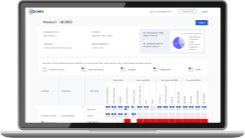
Want to evaluate your team’s skill gaps?
Do a quick Skill gap analysis with Edstellar’s Free Skill Matrix tool

Transform Your L&D Strategy Today
Unlock premium resources, tools, and frameworks designed for HR and learning professionals. Our L&D Hub gives you everything needed to elevate your organization's training approach.
Access L&D Hub Resources.svg)
.svg)



.svg)
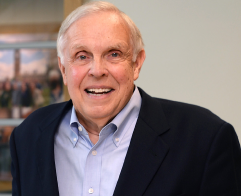

.svg)
.svg)
.svg)
.svg)

